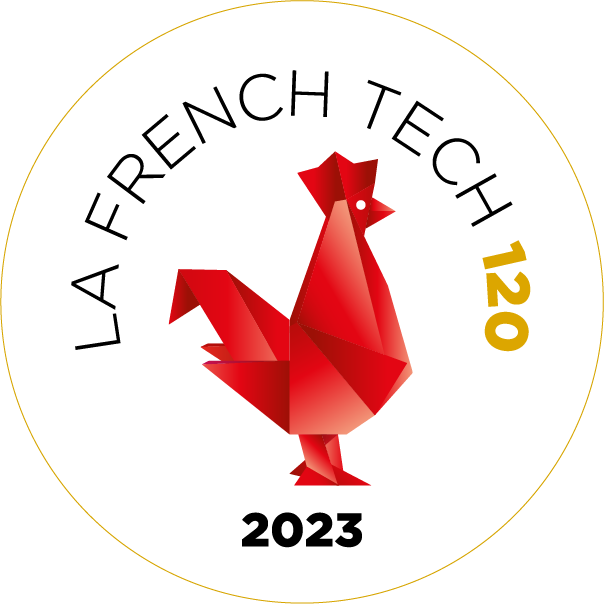In the summer of 2024, Kinéis, a French satellite operator and provider of global connectivity for the Internet of Things (IoT), will launch its constellation of 25 nanosatellites, the first European constellation dedicated to the IoT with global coverage. Satellite constellations are rare, but the deployment of the Kinéis constellation is an unprecedented event which, in addition to its operational performance, highlights a new space sector. Why have these players turned to nanosatellites? How are these small satellites the future of New Space? What are the special features of the nanosatellites in the Kinéis constellation?
Everything you always wanted to know about Kinéis nanosatellites... but were afraid to ask.

Kinéis nanosatellite during vibrations tests, in Toulouse ©Kinéis_ThierrydePrada2023
Nanosatellites: the miniaturization revolution
Since the 80s and 90s, the telecommunications and consumer telephony industries have made it possible to bring high-capacity electronic micro-components onto the market at affordable prices. Until then, space agencies and manufacturers designed and built large satellites the size of a car or a mini-bus, proportional to the size of the payloads (the mission instruments).
These satellites were expensive to manufacture, and their technical qualification and testing took a very long time, because the qualification of the electronic components used and the radiation and vibration tests had to be taken into account. There was a time lag of 10 to 20 years between phase zero of the projects and satellite operation.

Engineers therefore took a closer look at the electronic micro-components used in telecommunications and consumer telephony, which integrated all the functions into a single component. This reduction and functional concentration of components led to a reduction in the complexity of the systems.
After subjecting them to technical qualification tests, space R&D engineers used these micro-electronic components from the world of telecommunications, which offer greater computing capacity while being much cheaper and consuming little energy. These components are found in payloads supporting telecom or IOT missions (as is the case with Kinéis and its payloads), but also in on-board computers or energy management/distribution equipment supplied by the satellite platform.
Satellites suddenly became smaller as they adapted to these new scales.

Electronics initiated miniaturisation, generating a virtuous circle: around ten nanosatellites could be produced for the price of one satellite. This economic logic also led to the decision to develop systems based on constellations, projects that were previously much more expensive with standard satellites.
Launchers have adapted: private companies have designed micro-launchers to put these nanosatellites into orbit. The ticket to space has become much more affordable compared with the access offered by large launchers, which have become oversized. In the case of Kinéis, each of the 5 launches will carry just 150kg of payload (5 nanosatellites). The choice of a micro-launcher was therefore well suited to the needs of the Toulouse-based company for the deployment of its constellation.

Rocket Lab Electron micro launcher ©RocketLab
Kinéis nanosatellites: innovation for global connectivity
The Kinéis nanosatellite has a volume equivalent to 16 milk cartons and weighs just 28 kg. With its solar panels deployed, it measures 1.40 m (height) x 1.60 m (length), so you could almost hug it! This little satellite is a real high-tech jewel of the space industry "made in France". It combines unique know-how, both for its navigation and for its 2 missions: the Internet of Things and AIS (automatic maritime identification system).

©Kinéis2024
3 antennas for IoT and AIS missions
The antenna system is one of the special features of the Kinéis satellites, in particular the double UHF-S self-deploying antenna. The size of nanosatellites meant that a new concept of small, foldable antenna had to be designed and developed.
The dual UHF-S antenna meets these requirements, consisting of a foldable UHF antenna to which a rigid S-band antenna is attached. The assembly has been qualified with regard to launch conditions (vibrations), particularly high-performance requirements for this type of small-message collection mission, and its compactness.
The deployable UHF (Ultra High Frequency) antenna is dedicated to IoT connectivity. A product of CNES R&T, it was co-designed by Cobham Aerospace Communications and Comat, and produced by Comat, a Toulouse-based company. This antenna provides highly sensitive reception of messages transmitted by IoT terminals deployed on Earth. It can also transmit small messages to these same terminals. Its innovation lies in its 4 rigid metal strands made of beryllium copper (a hard, light metal) resembling a DNA chain, which perform 2 functions: radiating radio frequencies for the IoT and playing a role in the antenna's deployment mechanism.

UHF Kinéis antennas in production at Comat ©Kinéis2024
The S-band antenna (designed and produced by Cobham Aerospace Communications) communicates with the 20 ground stations in the Kineis system to relay mission data collected on board.
Another demonstration of innovation is the AIS (Automatic Identification System) antenna, which features a disruptive technology developed specifically for the 2nd Kineis satellite mission. It is dedicated to the maritime Automatic Identification System (AIS), an anti-collision system that enables ships and maritime traffic surveillance systems to know a vessel's identity, status, position and route in a dense shipping or fishing zone.
The Kinéis AIS antenna ensures better reception, since a ship's signal is received by each of its 6 independent stainless steel metal strands. This system increases the ship reception rate to 80% (daily detection rate on large ships) in areas with high shipping density (Northern Europe, Singapore), compared with single-strand satellites, which achieve 10 or 20% detection.

AIS antenna wires on the Kinéis nanosatellite ©Kinéis2024
The IoT payload
The instrument that carries out the IoT mission is 10 times smaller in volume and mass than previous generations of satellites. Thales Alenia Space and Syrlinks have met the technological challenge of miniaturising the payload, which consumes 3 times less energy than current IoT payloads.
The electric thruster
Not all satellites are equipped with a thruster. This feature enables 4 actions to be taken on Kinéis nanosatellites:
1. Positioning the satellite in its orbit, after separation from the launcher,
2. Maintaining the satellite in orbit,
3. Debris avoidance manoeuvres,
4. De-orbiting, when the nanosatellite has to be disintegrated in the Earth's atmosphere at the end of its life, in accordance with the French law on space operations (LOS).
The electric thruster, powered by the 2 solar panels, enables the nanosatellite to maintain its defined orbit and therefore the Kinéis system to maintain permanent coverage accuracy.

The startracker
It could be the name of a science fiction film: the star seeker! A mixture of Star Trek and Luke Skywalker, this poetic and cinematographic name is one of the instruments in the Kinéis nanosatellites. It is the equivalent of the sextant, the maritime navigation instrument that indicates the latitude and longitude of the earth in relation to the stars, and which enabled Magellan to circumnavigate the globe for the first time in the 16th century. The startracker photographs the space environment within its field of vision. It has on-board star mapping that enables it to see how the satellite is oriented in its orbit, so that it can correct it if necessary.
This startracker also includes an innovative component developed by Sodern. Sodern has developed a smaller but high-performance optical head for the mini-micro satellite range, and has miniaturised the electronic board controlling the startracker.
Small but powerful!
The 25 nanosatellites in the constellation are positioned in 5 low polar orbits 650 kms from the Earth, so that they can fly over the entire globe, enabling them to:
- Travel at a speed of 7.8 kms per second,
- Complete a full orbit in just 97 minutes,
- Complete 15 orbits in 24 hours.
Each Kinéis nanosatellite, which operates in groups of 5, also provides remarkable coverage:
- An area of 5 km²,
- That's 40,000 km2 covered per orbit revolution.
In comparison, it takes a 'normal' satellite 10 hours to cover the surface of the globe.
This constellation, optimised on 5 orbital planes and perfectly controlled at all times via electric propulsion, is the DNA of the Kinéis system, a veritable revolution in satellite IoT. Thanks to this constellation of 25 nanosatellites and a network of 20 ground stations, it is possible to connect any object in the world and transmit data to the end user in near real time.
Everything you need to know about the constellation
An unprecedented event, founding the new French space sector
Miniaturisation has made it possible to produce nanosatellites at considerably reduced prices. In line with the economic logic of the New Space, the design of a constellation like that of Kinéis has become more affordable, guaranteeing unrivalled revisit times for data users.
A pioneer in the new French space sector, Kinéis is deploying its first IoT constellation to meet the connectivity needs of the global market for the Internet of Things, and in particular to cover the white zones of terrestrial networks.
Kinéis nanosatellites have nothing to be ashamed of in terms of their size, as they are able to carry out their missions with performance levels rarely achieved. Ultimately, they are the driving force behind this revolution in the satellite-based Internet of Things, with applications that respond to the major challenges of the 21st century for mankind, its activities and its environment.
Author : Sébastien Martignac
In collaboration with Michel Sarthou, Technical Director, and Stephan Lauriol, Systems Engineer, at Kinéis


About us
Created in 2018, Kinéis is a satellite IoT operator.
© kineis - IoT everywhere - 2023
Contact us
Adress
11, rue Hermès
31520 Ramonville-Saint-Agne
France
Phone
+ 33 5 61 39 47 00
Links
FAQ
Press
Newsletter
News
Privacy Policy
Cookie policy
Sitemap
Let's stay connected






